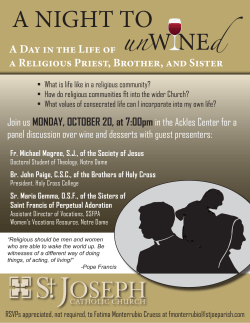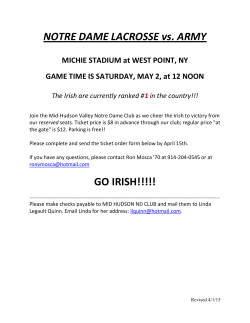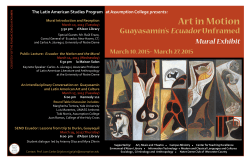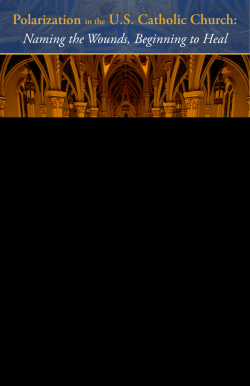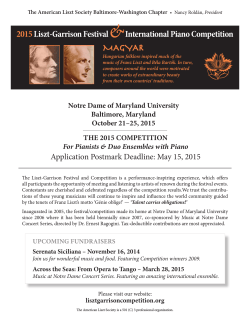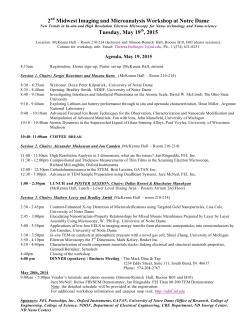
Notre Dame`s Forgotten Freedom - Sanity and Social Justice .net
Notre Dame’s Forgotten Freedom By Albert J. Schorsch, III © Copyright 2009, Albert J. Schorsch, III All Rights Reserved 4/18/09-5/31/09 -Neque enim censebat ille felicem esse rem publicam stantibus moenibus, ruentibus moribus. S. Aurelii Augustini, De Civitate Dei Contra Paganos, I, xxxiii -Neither did he count that republic as happy, having standing walls, but ruined moral standing. St. Augustine, The City of God, I, xxxiii -I wish the intellect to range with the utmost freedom, and religion to enjoy an equal freedom; but what I am stipulating is that they should be found in one and the same place, and exemplified in the same persons. Blessed John Henry Cardinal Newman, “Intellect, the Instrument of Religious Training,” Preached on the Feast of St. Monica, Sunday after Ascension, 1856, in the University Church, Dublin. -- Acting upon one’s own freedom of conscience shines forth more courageously when one defends similar freedoms on behalf of others. Can then a free university further the general cause of freedom by giving an honor to a President who moved to limit protections for the freedom of conscience of medical professionals? Can the University of Notre Dame’s conferring an honorary doctor of laws, honoris causa, to President Barack Obama advance human rights, if the recipient is a former legislator who failed in some instances to recognize, as to be reflected in the law, perinatal human rights? One of Notre Dame’s proudest episodes was its 1954 defense of John Courtney Murray, SJ, in the face of Vatican pressure, prior to Fr. Murray’s serving as peritus and initial principal drafter of the 1965 Vatican Council II Declaration on Religious Freedom, Dignitatis Humanae. Since this document stated that such freedom “has to do with immunity from coercion in civil society,” why then in the US President’s case did Notre Dame set aside the very defense of religious freedom, one of its own principal historic causes? What has this university forgotten about itself? Part of the answer to this riddle of forgetfulness lies in the development of Notre Dame’s extremely valuable brand—one of the most recognizable brands in higher education if not in American marketing. Notre Dame’s brand differentiates itself by substantially establishing its reputation for academic freedom against the foil of official Catholic teaching, and rarely in opposition to any other significant power. Another part of the answer is that Notre Dame’s brand has come to appropriate whatever it can—including aspects of Catholicism which usefully set it apart from other universities—for its own sake. Notre Dame looks Catholic, sounds Catholic, walks and talks Catholic, even smells Catholic, but in very important ways it has chosen to reorder its brand as “the unCatholic,” that is, in the service of other powers standing prior to its own God. The Presidential degree reveals more about the corporate brand that dominates Notre Dame than it does about the particular charism which Notre Dame shares with and within Roman Catholicism. A further part of the answer to the question of how Notre Dame forgot itself lies embedded in the story of a city, a university, a leader, money—lots of it, vainglory, and of elite social networks within the generations who came of age 50 years ago and who changed their minds about the Church. We must therefore reflect on Notre Dame’s nature to better understand this moment of its grace. It is not enough to say that Notre Dame had a lapse, and did a bad thing, and now needs to do a good thing, or should obey this rule instead of that rule. Notre Dame must now rediscover what it is. Between the Notre Dame we today seem to see and Notre Dame as it is there lies a hidden and powerful gravitational force pulling this fine university away from its proper orbit, and subtly distorting its true image through something of a spiritual phase-shift before it reaches our apprehension. Despite its mantra of “God, Country, Notre Dame,” Notre Dame University modulated the order to “Notre Dame, Country, and God,” by giving the Presidential Degree. The nova that was the honorary doctorate in law for President Obama lit up the source of Notre Dame’s distorting gravitational force for all to see. Such galactic language might indicate that some time-travel may be in the offing. This essay does recap a brief history, both natural and spiritual, of Notre Dame, to better understand how this university came to this moment. And by the end of this essay we will look to the future to argue that religious and related freedoms can be formally rejoined within Notre Dame on a co-equal basis with academic freedom, so that this fine university is spared another such embarrassment. This essay also is meant to lay the groundwork for a necessary but separate discussion on the question: Is the implicit American Catholic strategy of Notre Dame as the premier American Catholic university the right, and even the sustainable strategy? We next must consider Notre Dame’s environment, and the lengths to which Notre Dame has gone to sustain itself, in order to describe some of the events of Commencement 2009 in their embedded context. Universities, as the University of Chicago’s own late Nobel laureate Milton Friedman famously put it, besides such means as teaching and research, make money by “selling monuments.” Chicago’s Francis Cardinal George, OMI, in his own way noted this. While visiting Notre Dame’s Center for Ethics and Culture in 2003, His Eminence was videotaped quipping to then Notre Dame President Edward Malloy, CSC, at the beginning of the Cardinal’s talk on the legacy of John Paul II, that, “I see all the Chicago names—the result of so much Chicago money.” Notre Dame is indeed truly exceptional, and has had to rely heavily on the “Chicago names” and the “Chicago money,” since time, geography, and Cardinal Newman are not on its side. Let me explain: John Henry Newman had prescient insight into the relationship between a university and a great city, and understood how such a city not only served as a university in a virtual sense, but that a university resembled a city as “a place of concourse.” In my interpretation of Newman, this relationship between a city and a university, while metaphorical, is also essential. Due to space limitations, I refer you to Newman’s mellifluous second chapter of his Rise and Progress of Universities, readily available at the www.newmanreader.org website, for your further illumination and the enjoyment. Newman stated therein of a city, that “In every great country, the metropolis itself becomes a sort of necessary University,” and stated of a university, that “In the nature of things, greatness and unity go together; excellence implies a centre.” To achieve long-term success however defined, a university must embed itself deeply into a web of generational linkages with one or many cities. Notre Dame faces the challenge of being a prominent modern private doctoral research university that is not in a major city, and in claiming to be a Catholic university, to boot. Notre Dame stands near the south bend in the St. Joseph River, which flows north and west from that point toward Lake Michigan, but this waterway was a much more significant vessel of trade and of commerce in pioneer days, when a portage near South Bend, Indiana led to the Kankakee River, and thus to the Illinois and Mississippi basins. Over the course of a century and one half, Notre Dame had to make itself its own crossroads, and had to pursue that common strategy of many universities outside big cities: build itself as well into an Arcadian and pastoral retreat—which has greatly strengthened its capacity to serve as a relatively undisturbed environment for the formation of young adults, and as the locus of green and golden, in this case blue and golden, memories for alumni. Situated away from a major city, like several of America’s land-grant state universities, Notre Dame is similarly dependent on a massive transfer of wealth across a span approaching one hundred miles in order for it to economically thrive, and upon an extensive and expensive publicly-supported link of highway, rail, and air infrastructure to Chicago and other urban areas. Like other rurally-located universities, Notre Dame must locate a major outpost of its business school in the nearest major city, in this case also Chicago, in order for this school to be viable and competitive. Notre Dame’s innovative Urban Plunge programs, now spread beyond Chicago, boosted the social engagement of its students, and especially improved the quality of campus life for its sometimes-isolated urban minority students, allowing Notre Dame students to reach beyond the postindustrial town of South Bend, site of the long-shuttered Studebaker factory. Realizing its dependence on Chicago, Notre Dame has aggressively expanded its trustee and fundraising base beyond Chicago nationally and internationally by establishing outposts in Rome, Jerusalem, Dublin, London, and elsewhere. But still today, a significant portion of its trustees, donors, alumni, as well as football and conference attendees, still work or dwell in Chicago, this university’s clear economic foundation. Perhaps no institution has worked the Chicago “names and money” as well as has Notre Dame. The late activist Msgr. John J. Egan of Chicago, who served at Notre Dame from 1970 to 1983, was very fond of telling the story of how the then Notre Dame president, whom he served for a time as an assistant, returned the six-figure check of a Chicago multimillionaire on the spot, “without batting an eye,” when the price for a “fitting” memorial to a deceased family member was not right. Notre Dame has been quite savvy in understanding the “monument business.” Notre Dame has with more mixed success obtained the “Washington money.” Notre Dame’s circa 1978 decision to become a doctoral research university as classified by the Carnegie Foundation for the Advancement of Teaching, and its 2005 stated intention to seek membership in the invitation-only Association of American Universities (AAU), an elite 62-member organization, require Notre Dame to engage in an insatiable quest for, well, money. Catholic University of America (CUA), an AAU charter member since 1900, coincidentally withdrew from AAU in 2002, because, in the words of CUA president Very Reverend David M. O'Connell, CM, CUA’s “institutional emphases and energies are different than those of most of our colleague institutions in AAU.” Whether Notre Dame attains “firefighter” status by rushing into the AAU building being vacated by CUA remains to be seen. Notre Dame’s present annual research expenditure figures (one way higher education measures itself), in the annual $80-90 million range, are positively Lilliputian when measured against the top American research universities, which top off with Johns Hopkins’s astounding research totals exceeding $1 billion annually. Notre Dame therefore has a very strong vested financial interest in “cutting its own deal,” as separate from the US Catholic bishops, with the President of the United States. At first glance there thus seems very little chance, save with divine help to pass through the eye of such a needle, that the President of the University of Notre Dame could both afford to confront the President of the United States by denying him an honor on principle, and at the same time to seek to significantly advance as a major federallyfunded research university. This may partially explain the prostrate flattery contained in the tributes offered the US President by the Notre Dame President John I. Jenkins, CSC, on May 17, 2009 during this university’s one-hundred and sixty-fourth commencement, or the comments made that day by Notre Dame Provost Thomas G. Burish, despite Notre Dame’s previous protestations downplaying the significance of a doctorate for the US President as rather automatic, who stated that “Upon occasion universities also award doctoral degrees, not for the demonstration of potential to improve the world, but for its actual accomplishment. These doctorates, given as honorary degrees, are much more difficult to attain. For, as uncommon as it is to demonstrate extraordinary potential, it is even more uncommon to realize it.” Does Notre Dame’s granting of an honorary doctorate indicate their faculty leadership, trustees, and president are “easy” on the issue of honorary doctorates? Arizona State University, which hosted a commencement address by President Obama on May 13, 2009, explained through their spokesperson Sharon Keeler their lack of granting an honorary doctorate to the President by saying, “It's our practice to recognize an individual for his body of work, somebody who's been in their position for a long time. . . His body of work is yet to come. That's why we're not recognizing him with a degree at the beginning of his presidency.” The University of Chicago, well-known for being “hard” in granting honorary doctorates, proudly explains on their website that their university “does not honor actors, ambassadors, presidents or monarchs unless they meet stringent requirements for scholarship." Granting the benefit of the doubt, Notre Dame is “easier” than two universities spanning the arid climes of Arizona State to that sunken recollection of the original Chicago swampland, the Midway Plaisance at University of Chicago. To be absolutely fair to Notre Dame, I suspect that down the road the University of Chicago itself may find very, very good–if not even stringent—scholarly requirements met, notwithstanding the possible future location of a certain presidential library on some of that very same former swampland, for granting its former adjunct professor of constitutional law an honorary doctorate, too. If anything, despite the protestations of the university committees which vote on honorary degrees, in many cases these degrees are no less strategic than they are honorific: Witness Notre Dame’s generation-spanning flattery of the Roman Curia, Our American Presidents, and the Commonweal Magazine masthead and donor lists with commencement honoraria. President Obama’s speech was preceded by one more telling and important than his, given by the bright, capable, generous, and committed Notre Dame valedictorian E. Brennan Bollman. Ms. Bollman is destined for Harvard Medical School—where she may form her own opinion on whether her rights to religious freedom of conscience as a future medical professional may be curtailed by the very same President whose respectful manner in differing with Catholic teaching she so valued in a television interview. Ms. Bollman’s address, filled with love, curiosity, and passion, was the speech of the most lasting value by far given on her commencement day, because she revealed what Notre Dame gave her. Her transparent comments on learning, community, and conscience closely mirrored the Notre Dame Mission Statement, demonstrating that when a university sets out systematically to teach a student something, many of the students “get” whatever that something is. Her statements, like the Notre Dame Mission Statement, did not specifically address the religious freedom question. But the 2009 Notre Dame commencement was about much more than an academic honor for a President. It was about a political boost. Notre Dame “tossed in” a much more valuable gift than a doctorate, and one essential to the President’s political success: the promise of a continued division in American Catholicism. Previous US Presidents have gratefully rewarded previous American Catholic religious leaders with prestigious favors and citations for helping, among other things, to keep Catholicism safe for the political party of their choice. Writing as a Chicago urban planner, it is plain that a boon Notre Dame might seek with the sympathetic attention of the US President is high speed rail from Chicago to South Bend, just as any state university president in the agricultural greenbelt would want a similar yellow-brick high-speed link to their own corresponding Emerald City. So far, South Bend’s high-speed leg is in Phase II of President Obama’s high-speed rail proposal, which is this side of never. There is an old university president joke (amazingly, there is such a genre) that hell for university presidents has two medical schools. A variant of the joke is that Notre Dame on earth never will have a medical school, but in hell Notre Dame has two. Perhaps whoever at Notre Dame may cut a deal on the high speed rail link will get to oversee both of them, permanently. The history of higher education is usually told in less diabolic fashion as the story of failure after failure, of retry after retry, with initiatives skipping from one institution and from one generation to the next, as John Henry Newman’s initial failure in his 1850s Dublin university venture only served to inspire others elsewhere. Robert M. Hutchins (1899-1977), the former 30-year old whiz-kid president of the University of Chicago (1929-45), anticipating modern theories of the “learning organization,” once remarked that he was proudest that his university tried and failed so many times. Notre Dame’s own opportunity to become a prominent Catholic university by drawing initially upon the wealth of Chicago was provided by the failed venture of another visionary who understood the relationship between a city and a university, George William Cardinal Mundelein, Archbishop of Chicago, 1915-1939. According to the 1926 account of biographer James J. Walsh, Mundelein made plans to combine Loyola and DePaul Universities, along with Rosary, Mundelein, and St. Xavier Colleges, into a proposed Catholic University of Chicago, to be headquartered in the administration building at what is now the University of St. Mary of the Lake in Mundelein, IL, within walking distance of his country residence at his showcase major seminary. Facing resistance, according to historian Edward R. Kantowicz, from other American bishops who worked in the Vatican against his designs that they feared would compete with Catholic University in Washington, DC, Mundelein was forced to abandon his plans—some considered these only pipe dreams—but not without directing funds from the annual Chicago portion of the Catholic University collection to help strengthen the medical school at Loyola University, Chicago—a very significant act of institutionbuilding on which I hope to comment in a future essay. Had Mundelein’s dream of a Catholic University of Chicago succeeded, Notre Dame may have not advanced beyond the Indiana football factory image that it worked so diligently to outgrow in the 1950s. This little-known tale of Mundelein’s vision for the once and future Catholic University of Chicago is one of the great what-ifs in the history of American Catholic education: Had Mundelein’s plan been realized, a Catholic University of Chicago, because of its integration with a larger great city, and thus built upon a more stable economic foundation than Washington, DC’s Catholic University of America, could arguably have been a greater university also than Notre Dame is today, and because of its medical school would have been much further down the road toward being a well-funded major research university—as measured both by research expenditures as well as by the intellectual standing of its research findings—and may have rivaled the University of Chicago itself. Maybe. . . Much would have depended on two rare commodities in higher education, leadership and Catholic faithfulness. Very, very few people really know how to lead big and complex universities, and fewer of those who do know actually succeed. Simultaneous Catholic faithfulness and competence in complex institutional leadership are exponentially rare. Notre Dame had for a time such a dually-gifted leader. At this point in the narrative, we can conveniently outline how Notre Dame made its way to the Obama Commencement of May, 2009 by telling the conjoined story of this Notre Dame leader and what is often called “his” university. On January 15, 1960, the New York Times quoted this leader’s statement on the Catholic Church’s stand on birth control in response to a now forgotten but then very famous American Episcopal controversialist Bishop James A. Pike: “We cannot reverse our position because it is based upon unchanging theological and philosophical principles regarding the nature and destiny of man, or marriage, and of sexuality, too.” This dually-gifted leader’s name is, of course, Fr. Theodore Hesburgh, CSC. And before you read more about him, and how Notre Dame moved from “unchanging theological and philosophical principles,” I must properly set the scene. You may have noted above my use of the Homeric epithet “Nobel laureate” before the name Milton Friedman. This is because university parlance is nothing if not vainglorious. Like the late raconteur and pianist Oscar Levant once said of Hollywood and tinsel: You can take away all the phony vainglory from a university, and you’ll find the real vainglory. So let us spin the newsreel headlines, and recap some of Notre Dame’s spiritual history by a march across time through the phony Notre Dame vainglory, from the early commencement address by William Tecumseh Sherman, past the Gipper (both of them), the Four Horsemen, Regis Philbin, Phil Donohue, “Beer, Beer for old Notre Dame,” Rudy, and that imaginary Notre Dame alumnus and fantasy US president Josiah Bartlet of TV’s West Wing, to the real Notre Dame vainglory: the sometimes unseemly cult of personality that arose over the years around the person of Notre Dame’s accomplished president emeritus, Rev. Theodore Hesburgh, CSC, STD, and tightly bound to this cult the myth of Notre Dame’s indispensible role as the premier American Catholic University. Fr. Hesburgh is unquestionably one of the leading university presidents in modern memory, whose life’s work touched and shaped American and international education and society. But we should not agree, as Notre Dame historian Leo Ward, CSC, put it, that “[Notre Dame’s] president is seen as a kind of auxiliary pope, automatically big and authoritative,” nor should we, as Notre Dame Magazine proclaimed during his departure from the university presidency in the Spring of 1987, that Fr. Hesburgh was the “American pope.” An auxiliary or American pope might presume the existence of an insipient or “Stealth” church that needed such leadership, a point I will address separately anon. Fr. Hesburgh served as the devoted and very creative pastor to the veterans’ community at Notre Dame after WWII. The STD after Fr. Hesburgh’s name is for his dissertation on Catholic Action from Catholic University of America, which he attended after seminary study in Rome, where he mastered several languages critical to ecclesiastical polity. Fr. Hesburgh and Notre Dame tracked both the overlapping Catholic Action and “Greatest” or GI Bill generations during their life-spans. Fr. Hesburgh and Notre Dame came of age as these generations did, and prospered as they did. Among Fr. Hesburgh’s first acts upon assuming the presidency of Notre Dame (as yes, a 35-year-old whiz kid) in 1952 were the widespread replacement of deans and some faculty in order to advance the university—a “new broom” action later to be made almost impossible by the faculty governance documents instituted by the same Fr. Hesburgh at Notre Dame after its reorganization under a predominantly lay board in 1967. After a very public conflict with sixty-five Notre Dame faculty over their published endorsement of Adlai Stevenson for president in October, 1952, Fr. Hesburgh then became one of America’s staunchest defenders of academic freedom. A long-standing university president learns to act as a benign deity, granting freedom of academic will to the created dwelling in the garden, in this case, the faculty. The university in this arrangement becomes something of an intellectual Eden, but an Eden in which the inhabitants are perpetually allowed to sin. Unlike the real Deity, the university president hardly ever exiles anyone out of the garden (except for the gravest of scandals, and for being rejected by their peers for tenure), but is expected to, like the demiurge of a cosmic sprinkler-system, make rain benignly on the good and bad alike, and to defend the garden’s freedom. Occasionally the president-deity is allowed to thunder, call together meetings, open new groves within the garden, make new buildings, and to move people from building to building, the latter being one of the few things—besides requesting urgent updates and reports at the very last minute—that he or she can do on short notice. If the president-deity lasts in this arrangement a sufficiently long time, the garden’s grateful inhabitants will erect to him or to her a memorial. There are several memorials to Fr. Hesburgh at Notre Dame, among which are: the famous and eponymous library with the image of “Touchdown Jesus,” the Hesburgh Center for International Studies (named at Joan Kroc’s insistence), and statues of Fr. Hesburgh and of the late Fr. Edmund “Ned” Joyce, CSC, Notre Dame’s master builder, outside the library. The difference between God and Fr. Hesburgh, as another old joke in the university president genre ran, was that while God was everywhere, Fr. Hesburgh was everywhere but Notre Dame. To be fair, as Fr. Hesburgh’s autobiography was careful to point out, he was at Notre Dame over two-thirds of the time. The other roughly third of the time away was spent fundraising, serving on important government missions and commissions, with Catholic organizations, university associations, foundations, and nongovernmental organizations, and with various think-tanks, such as the Center for the Study of Democratic Institutions, a now-defunct but then important organization founded by the same Robert M. Hutchins mentioned earlier. The first talk Fr. Hesburgh gave at Notre Dame on his first day of service as president in 1952 was coincidentally to the Christian Family Movement, a still-existing though today much smaller Catholic Action movement than it was in its heyday. CFM’s then leading couple, Patrick and Patty Crowley of Chicago, who had met at a Good Friday service at Notre Dame circa 1937, transformed themselves along with Fr. Hesburgh over the following decades from sharers in the Catholic Action calling of service to humanity as a reflection of the Mystical Body of Christ, into sharers also of a sometimes condescending vision that thought it knew better than the Popes, especially on the matters of life addressed by Paul VI’s 1968 encyclical, Humanae Vitae. In a telling letter to the Crowley family read from the pulpit of Chicago’s Holy Name Cathedral at the end of Mrs. Crowley’s funeral on December 1, 2005, Fr. Hesburgh tipped his hand in recognizing the couple’s disappointment in Humanae Vitae—previous to which Mr. and Mrs. Crowley had served on the Papal Commission for the Study of Problems of the Family, Population, and Birth Rate—and their unrealized vision that each parish might become a center of responsible parenthood. In these years spanning 1952 and 2005, Notre Dame became a public meeting place in keeping with Fr. Hesburgh’s particular redaction of Newman’s university as a place of concourse, similar to the Hesburgh “lighthouse” and “crossroads” images picked up by President Obama on May 17 from the May 11 letter of Notre Dame President Fr. Jenkins to the graduating class of 2009. Just as Notre Dame had fought the Ku Klux Klan in the 1920s, had spread Catholic letters and neo-Thomism in the 1930s and 1940s, it spread movements thereafter within the Church in Catholic Action, in Civil Rights, of the Peace Corps (one of Fr. Hesburgh’s and Notre Dame’s proudest interventions) and similar Christian service corps apostolates sponsored by religious congregations, in Alinsky-style community organizing through the Catholic Committee on Urban Ministry as led for a time at Notre Dame by the previously-mentioned Hesburgh lieutenant Msgr. John J. Egan of Chicago, in the Charismatic Renewal, and later in the Sant'Egidio movement, which along with the Catholic Worker movement, Opus Dei, and others today enrich South Bend with small Catholic communities witnessing through several creative charisms. The years 1961 through 1967 especially saw coordinated in part from Notre Dame under Fr. Hesburgh’s leadership and from connected points elsewhere one of the most intense periods of change-agency in the Church, in which Catholic institutions of higher education and seminaries restructured themselves in opposition to papal and episcopal authority, so that by the promulgation of Humanae Vitae in 1968, the deed was already done. Notre Dame’s change-agency included both hosting a number of Rockefeller and Ford Foundation-funded conferences on population from 1963 to 1965, and included also leading the effort to establish governing documents for Catholic universities in national and international venues, giving these universities more independence from the Vatican. Paul VI himself, whose friendship Fr. Hesburgh had carefully cultivated as papabile with meetings in Europe and a several-day personal tour of the Notre Dame campus, and who as Pope had trusted Fr. Hesburgh with the leadership of the International Federation of Catholic Universities—and even presented Fr. Hesburgh with the ring of a bishop—was the last of the popes to afford Fr. Hesburgh such a sustained high level of trust and confidence. Several of the helpers in Fr. Hesburgh’s change-agency neatly listed themselves among the one-hundred sixty-six Catholic lay signers of a notable October 5, 1960 statement on the separation of church and state echoing and supporting John F. Kennedy’s September 12, 1960 Houston speech on the topic, but without naming JFK. The New York Times the next day quoted this lay statement, that a Catholic was “bound in conscience to promote the common good and to avoid the seeking of a merely sectarian advantage. . . He is bound also to recognize the proper scope or independence of the political order.” The purpose of this manifesto, according to the Times, was to allay fears that Kennedy’s view on church and state were not shared by Catholics. Among the signers were Catholic educators, journalists, politicians, labor leaders, business executives and others, including Pat Crowley, Senator Eugene McCarthy—whose 1968 presidential campaign Crowley chaired in Illinois—and George N. Shuster, a former Commonweal editor who introduced Catholic Worker co-founders Dorothy Day and Peter Maurin to one another, who served for twenty years as Hunter College president, and who ended his years as Fr. Hesburgh’s assistant at Notre Dame while working also with Hutchins’s aforementioned Center for the Study of Democratic Institutions. George Shuster played a key role as experienced in-house advisor to Fr. Hesburgh—a very smart move for a university president to keep an old-hand university president on staff—during this key period of ferment and change. Shuster also was deeply involved in Notre Dame’s institutional change-agency. In his thoughtful 1992 retrospective on Newman’s Idea of a University, Jaroslav Pelikan pointed out the importance of a university press. Both Fr. Hesburgh and Dr. Shuster beginning in the 1960s utilized Notre Dame’s and other presses significantly as a lever for change in education and in the Church. These Catholic Action and younger 1960s “New Breed” generations were vindicated after decades of struggle—Fr. Hesburgh had himself tangled with Cardinal Alfredo Ottaviani while defending John Courtney Murray, SJ’s speaking and publishing at Notre Dame in 1954 and thereafter—when Vatican II’s Declaration on Religious Freedom appeared in 1965. But by 1967, when Notre Dame’s governing documents were restructured under religious and lay fellow, trustee, and faculty governance, academic freedom was the only freedom that counted: religious freedom as framed by Vatican II remains today unmentioned in the Notre Dame Mission Statement, and in its Academic Articles, its Charter/Statute, and current By-Laws. Notre Dame under Fr. Hesburgh had labored and studied mightily, figuratively cramming late night by night to learn something not only unique about freedom but about itself, but in 1967, Notre Dame appears to have wearied in its own creative endeavors, and cribbed in the end from the conventional academic play-book of the American Association of University Professors. That Notre Dame, after a sustained struggle over decades to establish the principle of religious freedom in society, itself being an expression of religious freedom—and given the fact that the Vatican II Declaration on Religious Freedom was one document addressed not just to the Church but to the whole world—did not explicitly memorialize and formally establish within its own governance the very same principles, is a startling omission, an institutional oversight of the first order, and an act of self-absorbed 1960s hubris that continues to haunt this fine university to this very day. Notre Dame thus possesses something of a Midas blue-and-golden touch, an amazing capacity to appropriate something truly golden, like the Declaration on Religious Freedom, and to reduce it to a nugget of bluish, tarnished pyrite in Notre Dame’s own chaplet of vainglory. The Vatican II Declaration on Religious Freedom is important in its own right, not because Fr. Hesburgh played a role in the drama, although it is important and interesting to know that, but because it is important for the human race: all the more reason for Notre Dame faculty and students to actually read it, and for Notre Dame’s governance to reflect knowledge of it. Notre Dame’s contradictory honor to President Obama, despite his actions and inactions working against the right to life and against freedom of conscience, is thus a logical consequence based upon false premises. If academic freedom is the only freedom that counts, then here we have it: an honorary doctorate in law for a US President who in effect, contra the strained olive-branch rhetoric of his May 17th offer of a “sensible conscience clause,” by his actions limits the exercise of freedom of conscience for medical professionals. But if religious freedom also counts, then the University of Notre Dame has license to deny this honor to him, and still respect his office and his person— while still gradually increasing its federal research dollars, and eventually even getting that high-speed rail link—for the US President and other politicians will respect Notre Dame because it is predictably true to its authentic mission. Religious freedom is respected when religious freedom is exercised. Fr. Hesburgh himself exercised religious freedom when defending the Church’s stand on birth control in the New York Times in 1960. Notre Dame’s omission in not defending religious freedom of conscience in awarding the President an honorary degree, and Georgetown University’s covering up during the President’s April 14, 2009 Economic Address of the IHS, the symbol of the name of Jesus popularized by St. Bernardine of Siena (1380-1444) yet so associated with the later missions of the Jesuits, are also lapses related to the First Commandment. If Christ were truly alive for those responsible for this incident at Georgetown, and his symbolic emblem known, they would not have covered his name so quickly. Each of these fine Catholic universities has apparently chosen other gods, the gods of Caesar, by their lack of assertion of their own religious freedom. Academic freedom, a freedom to seek the truth, is a freedom derived in part from religious freedom, the freedom to seek God, whom the founders of the first universities equated with truth. Religious freedom founded Notre Dame, and founded Georgetown. Academic freedom and religious freedom can mutually strengthen one another. Religious freedom is the answer to the question I posed near the beginning of this essay: The necessity to exercise and defend religious freedom is what Notre Dame forgot about itself. The startling omission of the relationship between religious freedom and academic freedom is not only apparent in Notre Dame’s governing documents, but was missed in four of the most important joint statements made by Catholic universities, with Notre Dame’s significant participation, from 1967-72: the 1967 “Land o’Lakes Statement: The Nature of the Contemporary Catholic University,” which was later adopted by many US Catholic colleges and universities; the 1968 “Kinshasa Statement on the Catholic University in the Modern World of the International Federation of Catholic Universities;” the 1969 “Rome Statement on the Catholic University and the Aggiornamento,” which was produced by the Congress of Catholic Universities; and the culminating 1972 document of the Second International Congress of Delegates of Catholic Universities, “The Catholic University in the Modern World,” which did mention respect for religions other than Catholicism, and freedom of conscience, but again not religious freedom explicitly. Ex Corde Ecclesiae (1990), the Apostolic Constitution on Catholic Universities, directly addressed, albeit briefly, freedom of conscience. But Benedict XVI’s April 17, 2008 Catholic University of America Address to Catholic Educators went directly to the heart of the question underlying considerations of freedom, by stating that “Freedom is not an opting out. It is an opting in–a participation in Being itself.” Religious freedom is not only recognized by the First Amendment of the US Constitution, but it also was one of the first human freedoms, and is closely related to the First Commandment, to “not have other gods besides me” (Exodus 20: 3). We forget that the Lord commanded Moses to tell Pharaoh to let his people go for a reason, “to worship me” (Exodus 7:26). Each day in the Liturgy of the Hours, Catholics pray the Benedictus of Zechariah (Luke 1: 70-75): This was the oath he swore to our father Abraham: to set us free from the hand of our enemies, free to worship him without fear, holy and righteous in his sight all the days of our life. For believers in the Abrahamic traditions, human freedom is inseparable from religious freedom. Academic leaders understand academic freedom as a fundamental principle. For Catholics, the right to life, and the right to defend life through religious freedom, are both primary rights. Can this principle and these rights coexist in a modern university? Negotiation theorists advise against bargaining solely about money--because positions “harden” without room for compromise or agreement if only money is considered--but on broadening the conversation to include other concerns. For academics, their own freedom is similarly “coin of the realm”—a phrase also used in a different context by Fr. Hesburgh in a 1967 statement, “The Vision of a Great Catholic University in the World Today,” when referring to intellectual competence, which he considered the “best and only traditional authority in the university.” If the Academy and the Magisterium confine the conversations to academic freedom alone, such reduced and “bunkered” positions are inevitable. Universities, despite their trumpeting claims on behalf of academic freedom, are often beset by academic freedom’s flip side: supine conformity among graduate students and junior faculty, who in fact feel particularly constrained from sharing their personal views privately or publicly if they are divergent in any way from the dominant outlook of a given faculty. Wall Street Journal editorialist William McGurn wrote on May 19th that “a number of pro-life [Notre Dame] professors tell me they must not be quoted by name, lest they face career retaliation.” So much for both academic and religious freedom at Notre Dame. Jaroslav Pelikan’s 1992 retrospective on Newman’s Idea of a University saw the Vatican II Declaration on Religious Freedom as guaranteeing that Catholicism would not force conformity with its views when it achieved a majority. But paradoxically, the promise of academic freedom as reflected in promotion and tenure enforces a conformity within academic disciplines as extreme, if not more so, than any to be feared from Catholic authority. Therefore something else is needed besides reliance on intellectual competence and academic freedom alone to lead a Catholic university. Academic freedom by itself does not inevitably produce enlightened freedom, as conformity within universities demonstrates. Academic freedom can degrade to be the mere protective boundary of the intellectual garden of freedom which professors enjoy in order to serve other freedoms. But such academic freedom is, in a way, freedom without soul. Religious freedom can provide such soul. A Catholic university offering both religious freedom and academic freedom can offer to its students and faculty alike a fuller measure of freedom. We must expand our conversations about Catholic universities beyond “bunkered” positions to reflect our Catholic universities’ role in establishing, defending, and maintaining religious and other freedoms, and to consider how academic freedom serves these other freedoms. From Pope Benedict’s profound insight into freedom as participation in Being itself, we can build a revised foundational document for Catholic universities in the next generation that explicitly relates religious freedom to academic freedom, and allows universities, their faculties, and students, to explore specific ways in which they can exercise these freedoms simultaneously. Some theories of marketing hold that a brand does not reside within the institution that tries to build it and maintain it, but within the minds of those who think about that particular entity which is branded. A university loses control of its brand when its stakeholders become disenthralled with the messages of the image-makers and think independently about the university. The brand of Notre Dame has been shaken by the Presidential degree controversy, but the university in the long run will be helped by a constituency that makes up its own mind about Notre Dame. The New Media, no longer dominated as was the Old Media by Notre Dame’s humming chorus of old-boy and oldgirl talking heads who could be counted on to give Notre Dame “cover” in previous controversies with Catholic leadership, played a significant role in this change. Notre Dame’s constituents are beginning to realize the power they truly have to change the Notre Dame brand, by simply changing the way they themselves think about Notre Dame. Just as students shape the landscape of a campus by walking paths into the grass that the next generation paves, so can Notre Dame’s students, faculty, alumni, and friends change Notre Dame spiritually without a single vote of the trustees or faculty—by giving religious freedom respect in their everyday actions. Pro-life students praying at the Notre Dame Grotto during commencement exercised their religious freedom, which their university admirably respected. Such a student action and respectful institutional reaction can also go a long way to convert the cult of Notre Dame once again into its true charism within Catholicism. Another possible move in this direction would be to re-establish the primacy of Christ-centered iconography at Notre Dame, so that when students set forth to follow Jesus, they do not stumble, spiritually speaking, over multiple cenotaphs to Fr. Hesburgh (to be fair, a number of these he did not seek) or any other university figure. A future age may see Notre Dame’s library renamed, perhaps, the Library of the Holy Cross, not only after all of those in the Congregation of the Holy Cross, including indeed Fr. Hesburgh, whose priestly service remains so essential to the Notre Dame student experience, but also after Christ himself, whose Priesthood it first is, whose Cross it first was, and whose own Blood was first shed, so that others, in Notre Dame usage, could also devote their lives until their own “blood is in the bricks.” The essence of vainglory is to claim victory or peace where there is none, or credit for a deed incomplete or belonging to another. To Christ first be the glory, the peace, and the victory. We as Catholic citizens have a calling to defend through lawful means those innocent suffering harm. In the same vein the Catechism of the Catholic Church (#2265) points out the duty of the individual and the state to repel the aggressor. Therefore, a “dialogue only” position on life issues, or a “common ground” position to the degree that it may skirt the positive obligation of the Catholic lay person to work toward the political defeat of anti-life positions, seems a deceptive imitation. (Memo to Whomever the Shoe Fits: You can’t both help President Obama to write his speeches defending policies against life and claim yourself to be defending life.) Realpolitik leaders such as Rahm Emanuel and Richard M. Daley would change their positions on abortion on a dime if they thought it would consistently lose elections, as even President Obama has re-prioritized his approach to the Freedom of Choice Act (FOCA) in light of a pro-life shift in public opinion. President Obama’s commencement address, by its praise of the approach of the late Cardinal Joseph Bernardin, approached inappropriately prescribing an acceptable public theology for Catholics. It is not within the right or authority of any head of state to do so. While it is understood that a university cannot take a political position, Catholic laity, on the other hand, can and must protect the innocent by continually working to defeat antilife policies through the established political process, without rancor, but by simply utilizing democratic means for the purposes they were established: to resolve differences in an orderly way through the vote when dialog and persuasion cannot do so. This latter point on Catholic citizenship in defense of life can indeed be taught and acted upon within Catholic universities as an exercise of civic freedom in keeping with religious freedom. Should such a Catholic citizenship component be added to the Notre Dame Mission Statement, we might hear a future valedictorian speaking directly of Christ and of defending life. Present Notre Dame President Fr. Jenkins will happily not serve as American Pope in any sense. This proper reduction in the standing of the President of Notre Dame University to the status of, well, just the President of the University of Notre Dame—thanks to the unprecedented protests of dozens of bishops and hundreds of thousands of Catholics—is one of the most useful results of this controversy. Perhaps Fr. Jenkins can resume his non-papal duties by answering the question, What is Cathie Black, President of Hearst Magazines (publisher of Cosmopolitan Magazine—recent Cosmo headline: “Get Butt Naked”), a national champion of the “Vagina Monologues,” and a member of the exclusive seven-member “V-Counsel,” doing on Notre Dame’s Board of Trustees? There is a password-restricted file in the online Notre Dame Faculty Handbook entitled, “President’s Guidelines for Resolving Controversial Issues.” The Notre Dame President may have further need to refer to such a useful “In emergency, break glass” document until the question of the Catholic identity of Notre Dame is better clarified. In the mean time, it is expected that whoever holds the position of President of the University of Notre Dame will not be unequivocally recognized to speak for the Catholic Church in America for a very, very long time. The presidential degree controversy, like a business school exercise but on steroids before an audience of millions, has revealed that Notre Dame has been assuming for a half century that it was mostly in the academic freedom “business,” only to learn to its surprise that it has actually been in a much bigger and more promising business, the religious freedom “business,” a business which includes both the “businesses” of academic freedom and of human freedom. It is time that Notre Dame’s words and actions more directly reflect its commitment to religious freedom in Christ’s name. Religious freedom, after all, is not a bad “business” to be in. Notre Dame’s Forgotten Freedom By Albert J. Schorsch, III © Copyright 2009, Albert J. Schorsch, III All Rights Reserved
© Copyright 2025

